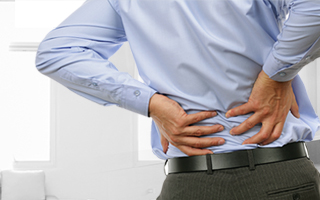Ankylosing Spondylitis - Symptoms
The most common early symptoms of ankylosing spondylitis include the following symptoms:
Pain and stiffness: Constant pain and stiffness in the lower back and hips is experienced for more than three months.
Bony fusion: Ankylosing spondylitis can cause an overgrowth of the bones, which may lead to abnormal joining of bones, called "bony fusion". This fusion leads to stiffness and restriction of movements.
Pain in ligaments and tendons: Spondylitis may also affect some of the ligaments and tendons that attach to the bones. This could lead to pain and stiffness of the joints.
Ankylosing spondylitis is a multi-system disease, which means the symptoms may not be limited to the joints. The patient may also experience fever, tiredness and loss of appetite.
Redness and pain in the eyes are experienced by some people with ankylosing spondylitis. In rare cases, lung and heart problems may also develop.
Five warning signs for ankylosing spondylitis:
- Unexplained pain in the lower back: Usually any back pain is better after rest. In ankylosing spondylitis, it is the opposite. Pain and stiffness are usually worse after waking up from sleep or getting up after sitting for a long time. Exercise usually increases the ordinary back pain, but in ankylosing spondylitis, the back pain is better after exercise. It is uncommon for teenagers and young people to complain of lower back pain, and that too constant pain. Teens and young adults who complain of stiffness or pain in the lower back or hips should be tested for ankylosing spondylitis.
- Having a family history of ankylosing spondylitis: The diagnosis is usually made by a detailed history of the nature of pain, the exact location and factors that increase or decrease the pain. Physical examination is done to check the restriction of movements in the painful area. Our doctors may also order tests, such as X-ray, of the painful joint. If the patient has a family history of either ankylosing spondylitis or psoriasis-related arthritis, they may have inherited the genes that put them at a greater risk for the illness.
- An unexplained pain in the heel(s), joints or chest of the patient: Instead of a back pain, some ankylosing spondylitis patients first experience pain in the heel or pain and stiffness in the joints of the wrists, ankles or other joints. Some patients rib bones are affected at the point where they meet the spine. This can cause tightness in the chest that makes it hard to breathe.
- The pain comes and goes, and it is gradually moving up the spine with more severity: Ankylosing spondylitis is a chronic, progressive disease. Although exercise and/or pain medications may help temporarily, the disease may gradually worsen. Symptoms may come and go, but they will not stop completely. Often, the pain spreads from the lower back up along the spine.
- The patient is relieved of the symptoms by taking pain-controlling medicines: Getting relieved of back pain with the help of common over-the-counter medicines such as ibuprofen or naproxyn do not cure ankylosing spondylitis; they provide only temporary relief from pain.
Diagnosis
Our doctors will take a detailed patient medical history to understand the exact nature of pain and how it started and progressed. They will also conduct physical examinations to confirm the diagnosis.
Our doctors may also try to reproduce the pain by pressing on specific portions of the patient’s pelvis or by moving their legs into a particular position. They might also ask the patient to try to stand upright with their heels and the back of their head against a wall. The doctors will do the chest expansion measurement to see if the rib cartilages are affected, because in ankylosing spondylitis, there is an inflammation of rib cartilages leading to a restriction of the movement of the chest.
The overall points considered to diagnose ankylosing spondylitis are as follows:
- the onset is usually under 45 years of age;
- the pain persists for more than three months (i.e. it is chronic);
- the back pain and stiffness increase with rest, especially at night and early morning;the back pain and stiffness tend to reduce with physical activity and exercise;
- relief from pain from pain- relieving medicines (nonsteroidal anti-inflammatory drugs); and
- the presence of the HLA-B27 gene in the blood.
Other blood tests such as the erythrocyte sedimentation rate and the C-reactive protein are useful to confirm the inflammation of the joint. X-rays allow our doctors to check for changes in the patient’s joints and bones.
Complications
In severe cases of ankylosing spondylitis, new bone forms as part of the body's attempt to heal. This new bone gradually bridges the gap between the vertebrae and eventually fuses sections of the vertebrae together. Those parts of your spine become stiff and inflexible.
Other complications may include the following:
Eye inflammation (uveitis) -One of the most common complications of ankylosing spondylitis is the sudden onset of pain in the eyes. Should this occur, immediate medical attention is advised.
Compression fractures -Some people experience a thinning of their bones during the early stages of ankylosing spondylitis. Fractures of the bones of the spine sometimes can damage the spinal cord and the nerves that pass through the spine.
Heart problems - Ankylosing spondylitis can lead to heart problems. The inflammation of some part of the heart can change the shape of the heart and cause disturbance in it normal functioning.
The jaw - About 10%of the people with spondylitis experience inflammation of the jaw. This can be particularly causing difficulty in fully opening the mouth to eat.
The chest - In ankylosing spondylitis-related chest pains the patient is unable to practise the critical deep breathing exercises, due to stiffness in the rib joints.





